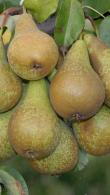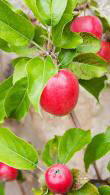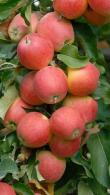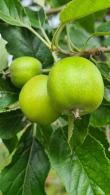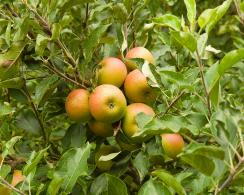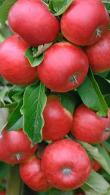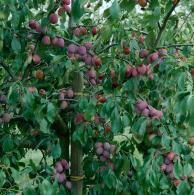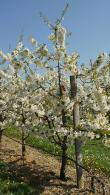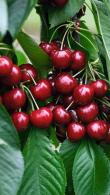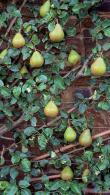Espalier Fruit Trees
Single Espalier, Fan Trained, Cordons, Single U & Double U Shaped Espaliered Fruit Trees
Espalier fruit trees are fruiting trees trained into space-saving, easily accessible shapes that still produce lots of tasty fruit. Espalier fruit trees come in many forms, all designed to detract energy from vigorous vertical growth while focusing on horizontal or lateral stems thereby producing enhanced fruit crops on short spurs. Our ever-growing espalier fruit tree collection currently includes the very popular simple horizontal espalier on several horizontal stems, fan-trained espaliers, cordons (or stepover) fruit trees on a single horizontal stem and both the Single U as well as the Double U form of espalier.
Espaliered fruit trees are common throughout history in formal gardens and have remained popular for several reasons.
- Because they grow against a wall or fence, espaliered fruit trees take up much less lateral room in compact gardens. This is a big plus point for urban gardeners and folk wanting to grow tasty fruit in ever-shrinking outdoor spaces.
- It is much easier to pick fruit from an espaliered fruit tree. Standard trees are large, so the top fruit is often missed. Espaliers take up little forward space and they are trained to reachable heights.
- Maintaining, pruning, and treating pests is easier on espaliers of manageable height and spread.
- Espaliers are grown against a wall or fence, which soaks up the sun’s heat and reflects light to help ripen the fruits more effectively.
- Ornamental espaliered fruit trees and fan-trained fruit trees look stunning.
What is An Espaliered Fruit Tree?
Espaliered fruit trees are trained to have a single vertical stem with several right-angled horizontal branches that bear fruit, typically called their ‘arms’. They have very little forward-reaching volume and most of the plant’s energy goes into flower and fruit production. Apple trees and fig trees are handsome small-sized espaliers that are perfect for small garden spaces or kitchen gardens.
What is a Fan Trained Fruit Tree?
Fan-trained fruit trees are similar to espaliers, but they have one vertical and several upwardly diagonal fruiting branches. On some fan-trained fruit trees, branches cover 180 degrees, resembling an opened fan with numerous struts.
Outstanding fan-trained fruit trees include the RHS AGM winning Conference pear, Discovery apple and Bramleys seedling cooking apple.
What is a Cordon Fruit Tree?
Horizontal cordons or “stepovers” as they are soemtimes known, have a low-growing single stem that’s trained to grow horizontally. This keeps the fruit low, with short fruiting side stems at a 45-degree angle and lateral fruit off the central stem.
Cordons are a practical way to enjoy heavy crops of fruits in a compact form. They take up much less lateral room, which makes them perfect for kitchen gardens, sunny borders, balconies, and compact urban gardens.
What is a Single U-Shaped Fruit Tree?
Single U, or U-shaped espaliered fruit trees have two vertical branches trained to form a U shape. This allows sunlight to reach a large surface area and produce more fruit as a result. U-shaped fruit trees are especially productive.
Simple but effective U-shaped fruit trees make a dramatic statement in a garden when they’re planted single file against a sunny wall or lined up in a regimental row. They’re most productive when they reach two to three metres tall. Apples and pears are most suited to this shape.
What is a Double U Shape Espalier?
With all of the U-shaped fruit trees benefits, double U or W-shaped fruit trees double the crop with four vertical branches. Vertical branches enhance air circulation which reduces humidity and the risk of fungal disease and rot. The extra branches provide a heavier crop of fruits. Double U cordons suit large well-watered and fed containers.
Deciduous and Evergreen Espaliered Fruit Trees
Both deciduous and evergreen fruit trees can be espaliered. Excellent deciduous espaliered fruit trees include pears, figs, and nectarines, which can struggle to fruit in the UK without enough sun. Arbutus, known as the Killarney strawberry tree, makes a splendid evergreen fruit espalier.
Maintaining Espaliered Fruit Trees
We offer a range of espaliered and fan-trained fruit trees to take the hard work out of setting them up. Once planted, they need regular pruning and maintenance to keep their space-saving trained shape.
Without annual maintenance, their compact horizonal and fan-shaped tiers will eventually revert to a more natural tree shape. Each year in late summer, trim back growth to three or four leaves above the basal cluster and remove any vigorous upright shoots.
